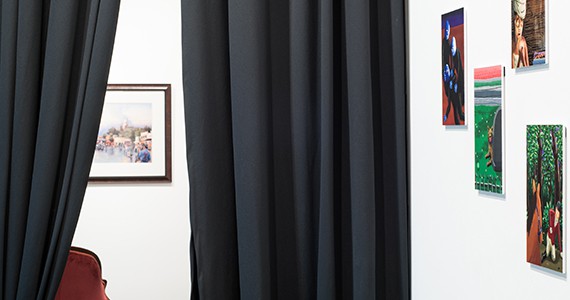PAINTING ON PUZZLES, greeting cards, and even La-Z-Boys, Thomas Kinkade may be the most ubiquitous artist in America—and possibly the most commercially successful—yet he was largely ignored by the art world during his lifetime. Kinkade died in 2012, but even in death his businesslike approach raises questions about contemporary art. This month, Upfor Gallery addresses that legacy with a group show, Pain Tero Flight, curated by writer Alicia Eler and Upfor director/owner Theo Downes-Le Guin.
Unlike Kinkade’s pastoral schmaltz, Pain Tero Flight‘s offerings are diverse, ranging from video art to a hilarious video/performance piece by comedian Maria Bamford to work that’s arguably more traditional, like a painting by Scott Marvel Cassidy (Bamford’s husband). Here are Eler and Downes-Le Guin on Kinkade’s enduring legacy—plus a look into their curatorial process.
THEO DOWNES-LE GUIN: The curatorial brief was very loose, but we did emphasize to artists that we hoped they would avoid easy, ironic reactions such as poking fun at kitsch. Part of what interested me is revisiting [Kinkade’s] work a few years after his death, in the context of some big changes in contemporary art, such as an art market that is an order of magnitude larger and more supply and demand-centric than it was in the ’90s. In the years since, many of contemporary art’s beliefs that it stands for something more than supply and demand have been challenged. Artistic careers are made very quickly in the marketplace, if not in art history, and audiences respond to art by its market value, likes, and clicks.
ALICIA ELER: [What] interested me as I kept researching Kinkade was that he is like the McDonald’s of art. There’s a Thomas Kinkade village where people live, somewhere in California; there was a deal between Thomas Kinkade and La-Z-boy. If a fine artist did that, it’d be like, “You sold out.” But Kinkade doesn’t have that worry, because he’s already so capitalist. Kinkade figured out a way to make capitalism work for him, and the art world is more a reflection of another type of economy that doesn’t quite work: Is it so wrong for Kinkade to have done what he did, with the goal of making a lot of money? I don’t know.
Read it on the Portland Mercury: http://www.portlandmercury.com/portland/that-capitalist-vision-of-thomas-kinkade/Content?oid=17577262




